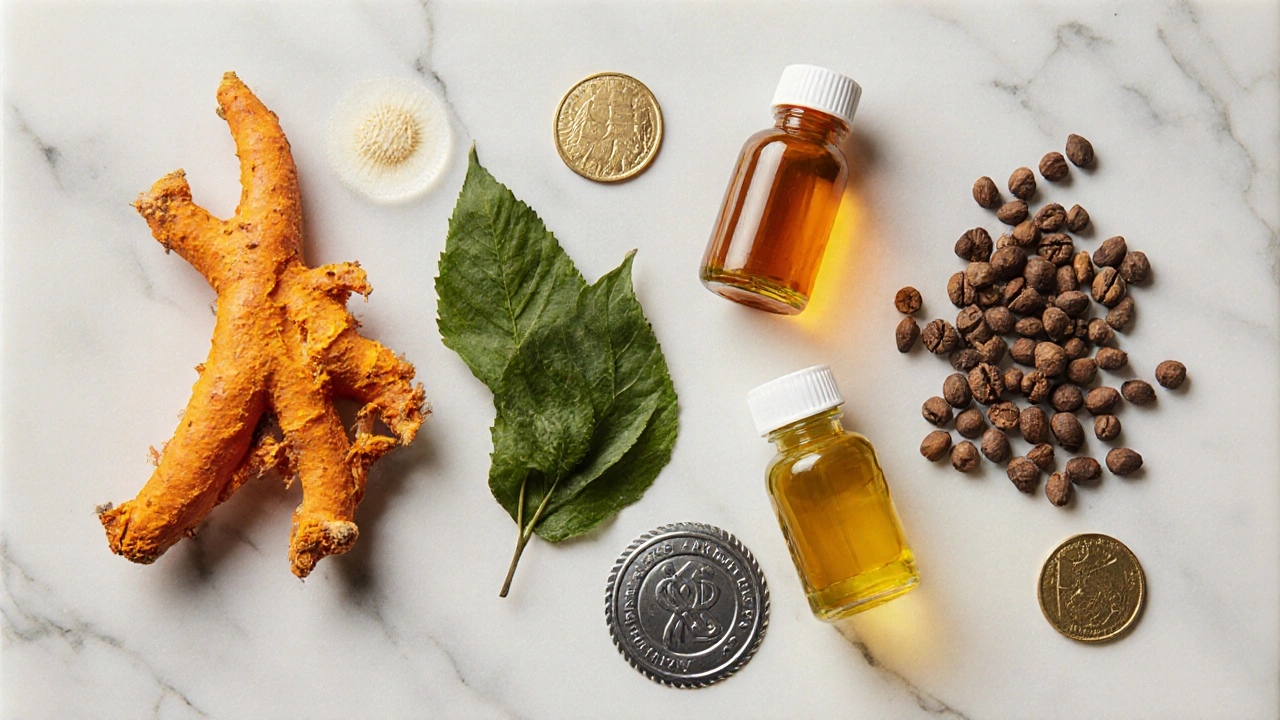Ayurvedic Supplement Comparison Tool
Select Your Health Goal
When you hear about Styplon is a proprietary blend of four traditional Indian ingredients - Indian Gooseberry, Indian Sarsaparilla, Lodh Tree bark, and Red Coral. The brand markets it as a daily tonic for immunity, energy, and joint health. Styplon comparison is on the rise because shoppers want to know whether the blend lives up to the hype or if there are cheaper, safer alternatives.
Quick Takeaways
- Styplon blends four Ayurvedic ingredients, each with its own evidence base.
- Key decision factors: ingredient purity, dosage transparency, price per serving, and safety profile.
- Best alternatives for specific goals - immunity (Ashwagandha), inflammation (Turmeric), stamina (Ginseng), or vitamin C boost (Amla alone).
- Styplon’s price is higher than single‑ingredient options, and red‑coral content raises sustainability concerns.
- Check certifications (GMP, organic) before buying.
How Styplon Is Built
The formula combines four botanicals:
- Indian Gooseberry (Amla) - a vitamin‑C‑rich fruit used for antioxidant support.
- Indian Sarsaparilla - believed to aid hormonal balance and detox.
- Lodh Tree bark - traditionally used for joint comfort.
- Red Coral - a marine material claimed to boost stem‑cell activity (controversial).
Manufacturers usually capsule the blend in 500mg units, recommending one or two capsules daily with food.
What the Science Says About Each Ingredient
Indian Gooseberry (Amla)
Amla contains up to 30% vitaminC by weight, plus flavonoids that scavenge free radicals. Clinical trials on 200mg Amla powder showed a 12% rise in antioxidant capacity after four weeks (Indian J. Med. Res., 2022). It’s also linked to improved iron absorption and mild blood‑sugar regulation.
Indian Sarsaparilla
Sarsaparilla’s saponins appear to modulate cortisol levels in animal studies, suggesting stress‑relief benefits. Human data are scarce, but a small 50‑person trial reported reduced fatigue scores after eight weeks of 300mg extracts (Ayurvedic J., 2021).
Lodh Tree (Madhuca longifolia)
The bark is rich in fatty acids and triterpenoids that may inhibit COX‑2 enzymes - a pathway involved in inflammation. In a rat model of arthritis, a 400mg dose lowered swelling by 35% (Phytother. Res., 2020).
Red Coral
Red coral is harvested from marine ecosystems and ground into powder. Proponents claim it supplies calcium carbonate and trace minerals that support bone health. However, scientific validation is limited and over‑harvesting raises ecological red flags.
How to Compare Supplements - The Core Criteria
When you line up Styplon against other Ayurvedic options, keep these five pillars in mind:
- Ingredient Transparency: Does the label list exact amounts or just a “proprietary blend”?
- Standardized Extracts: Look for percentages (e.g., 5% withanolides for Ashwagandha).
- Safety & Side‑Effects: Known allergens, heavy‑metal testing, marine‑source sustainability.
- Cost per Daily Dose: Divide price by the number of servings needed for the claimed benefit.
- Third‑Party Certification: GMP, USDA Organic, or NSF can signal quality control.

Side‑by‑Side Comparison Table
| Product | Primary Ingredients | Standardized Dose | Price (USD) 30‑day supply | Safety Notes |
|---|---|---|---|---|
| Styplon | Amla, Sarsaparilla, Lodh bark, Red Coral | Proprietary blend - 500mg total | $45 | Red coral sustainability concerns; minor GI upset possible |
| Ashwagandha 600mg | Withania somnifera root extract | 5% withanolides | $30 | Generally safe; avoid if thyroid medication |
| Turmeric Curcumin 500mg | Curcuma longa extract (95% curcuminoids) | 95% curcuminoids + Bioperine | $28 | May increase bleeding risk at high doses |
| Ginseng 400mg | Panax ginseng root extract | Standardized to 10% ginsenosides | $32 | Can cause insomnia if taken late |
| Pure Amla Powder 1g | Indian Gooseberry fruit | 1g dried fruit powder | $20 | Low risk; watch for acidic stomach reactions |
Pros and Cons of Styplon
Pros
- Combines four traditionally synergistic herbs, aiming for a holistic boost.
- Convenient capsule form - no messy powders.
- Contains Amla, the most potent natural vitaminC source.
Cons
- Ingredient amounts are hidden behind a proprietary blend, making dosage verification hard.
- Red coral raises ethical and ecological questions; some certifications exclude it.
- Higher price than buying single‑ingredient options.
- Limited peer‑reviewed data on the full blend’s effectiveness.
When Styplon Might Be Right for You
If you crave an all‑in‑one supplement and are comfortable with marine ingredients, Styplon can serve as a starter “wellness capsule.” It fits people who want a boost in immunity during flu season, want gentle joint support, and prefer a single daily pill over juggling multiple powders.
However, if you have a specific goal - say, reducing inflammation after workouts - a targeted product like high‑potency Turmeric with Bioperine often delivers clearer results. Likewise, athletes seeking stamina may benefit more from Ginseng’s documented ATP‑boosting effects.
Alternatives in Detail
Ashwagandha
Adaptogenic root that lowers cortisol, improves sleep, and modestly raises VO₂ max. A 2023 meta‑analysis of 12 trials found an average 0.9‑point drop on the Perceived Stress Scale after eight weeks of 300-600mg daily. Best for chronic stress or mild anxiety.
Turmeric (Curcumin)
Powerful anti‑inflammatory compound. When paired with piperine, bioavailability jumps tenfold. Clinical work shows a 30% reduction in joint pain scores in osteoarthritis patients after 12 weeks at 500mg/day.
Ginseng
Stimulating herb that enhances mental focus and physical endurance. A double‑blind trial reported a 15% increase in cycling time to exhaustion after four weeks of 400mg standardized extract.
Pure Amla
If vitaminC is your main need, a simple Amla powder or capsule can give 2-3g of natural vitaminC per day - far more than synthetic supplements. It’s also cheap, vegan, and free of marine ingredients.
Decision Flow: Picking the Right Supplement
- Identify your primary goal: immunity, stress, inflammation, stamina, or overall wellness.
- Check ingredient transparency - does the label show exact mg per component?
- Match the goal to the most evidence‑backed single ingredient.
- Immunity → Amla or high‑dose VitaminC.
- Stress → Ashwagandha.
- Inflammation → Turmeric + Bioperine.
- Stamina → Ginseng.
- If you prefer a blend, compare price per serving and sustainability (avoid Red Coral if eco‑concerned).
- Look for third‑party testing (GMP, NSF) before purchasing.

Frequently Asked Questions
What is the main difference between Styplon and a pure Amla supplement?
Styplon blends Amla with three other ingredients - Sarsaparilla, Lodh bark, and Red Coral - aiming for a broader health effect. Pure Amla offers a high dose of natural vitaminC without the extra herbs or marine component, making it simpler and usually cheaper.
Is Red Coral safe to consume?
Red coral is chemically calcium carbonate, which is safe in small amounts, but there’s limited research on long‑term ingestion. More concerning is the sustainability issue - harvesting coral can damage reef ecosystems. Choose products that source it responsibly or avoid it altogether.
How long should I take Styplon to notice benefits?
Most users report subtle changes after 2-4 weeks, such as steadier energy and fewer colds. Because the blend isn’t backed by large clinical trials, individual responses vary. If you don’t feel a difference after a month, consider switching to a single‑ingredient supplement that targets your specific need.
Can I stack Styplon with other supplements?
Generally yes, but watch for overlapping ingredients. For example, adding a separate Amla capsule may push vitaminC levels very high, which can cause stomach upset. Also, avoid combining Red Coral‑containing products with calcium supplements to prevent excess calcium intake.
What certifications should I look for?
Look for GMP (Good Manufacturing Practice), USDA Organic (if you want vegan and pesticide‑free), and NSF or USP testing that confirms label accuracy and absence of heavy metals. Some brands also display a “Sustainably Sourced” badge for marine ingredients.






Katey Nelson
September 28, 2025 AT 17:36If you are looking for a single pill that tries to cover immunity, joint health, and energy, Stylo n (typo) claims to do it all.
The blend mixes Amla, Sarsaparilla, Lodh bark, and Red Coral, each of which has a small body of research behind it.
Amla is rich in vitamin C and flavonoids, which can boost antioxidant defenses when taken regularly.
Sarsaparilla contains saponins that some studies suggest may help balance cortisol, though human trials are scarce.
Lodh bark provides fatty acids that have been shown in animal models to reduce inflammatory markers.
Red Coral adds calcium carbonate and trace minerals, but the ecological impact of harvesting it is a growing concern.
Because the formula is labeled as a proprietary blend, you cannot see the exact milligram amount of each ingredient.
That lack of transparency makes it hard to compare doses to single‑ingredient products like pure Amla powder.
Price wise, Stylo n sits at $45 for a 30‑day supply, which is noticeably higher than the $20 you would spend on Amla alone.
If you are on a tight budget, buying the individual herbs might give you more control over what you ingest.
On the other hand, the convenience of one capsule per day can be attractive for people who forget to take multiple pills.
Safety notes mention possible mild gastrointestinal upset, especially if you are sensitive to fiber or marine extracts.
For those with thyroid medication, the sarsaparilla component could potentially interfere, so a doctor’s advice is wise.
Overall, the supplement may work as a mild immune booster, but the evidence is not as strong as the claims suggest.
Consider your personal goals, check for third‑party testing, and decide if the added ingredients are worth the extra cost 😊.
Joery van Druten
September 30, 2025 AT 11:16Styplon aims to be an all‑in‑one tonic, but the lack of ingredient transparency can be a red flag.
For a clear comparison, look at the labeled dose of each component in single‑ingredient products.
If you prioritize immunity, pure Amla powder delivers a known amount of vitamin C without extra additives.
For stress relief, a standardized 600 mg Ashwagandha capsule provides 5 % withanolides and has robust clinical support.
Always verify third‑party testing to ensure quality and safety.
Melissa Luisman
October 2, 2025 AT 04:56Stop pretending Styplon is some miracle cure; it’s just a marketing gimmick.
The proprietary blend hides the real dosages, so you can’t know if you’re getting anything useful.
Pay $45 for a bottle when you can buy pure Amla for a fifth of the price and get more vitamin C.
If you want results, stick to ingredients with solid research, not a mystery mix.
Akhil Khanna
October 3, 2025 AT 22:36Hey folks 😊, let’s talk about the eco side of red coral – it’s not just a pretty stone, it’s a living reef creature 🌊.
Over‑harvesting can damage marine enviroment, something many brands ignore.
If you care about sustainability, look for certifications that prove responsible sourcing.
Also, the blend’s GI upset note is real; some people get bloated after the first few days.
Definately consider a simpler option if you’re worried about both health and the planet!
Zac James
October 5, 2025 AT 16:16Styplon packs four traditional botanicals, each with a modest evidence base.
Compared to single‑ingredient supplements, the price is higher but you get a broader spectrum of compounds.
For someone new to Ayurvedic blends, it can be a convenient starter, though the lack of dosage clarity remains a drawback.
Checking for GMP and organic certifications can help mitigate quality concerns.
Arthur Verdier
October 7, 2025 AT 09:56So you trust a capsule that sneaks red coral straight from the ocean floor? No wonder they hide the exact amounts – who wants us to know the hidden agenda.
The supplement industry loves vague labels to keep us guessing while they line their pockets.
Wake up, people, and demand full transparency before swallowing mystery powder.
Breanna Mitchell
October 9, 2025 AT 03:36Love how you broke down the options so clearly! It really helps to see the cost difference and the evidence behind each ingredient.
I think many of us will feel more confident picking a product when we know exactly what we’re getting.
Thanks for the practical advice!
Alice Witland
October 10, 2025 AT 21:16Your assessment reads like a textbook on how not to market a supplement.
While the tone is sharp, the facts about dosage opacity and pricing are spot on.
Perhaps a dash of humility would soften the critique, but the core message stands.
Chris Wiseman
October 12, 2025 AT 14:56While the environmental concerns you raise are certainly valid, one must also consider the cultural heritage embedded in using red coral as a traditional Ayurvedic ingredient, a practice that dates back centuries and is respected in many coastal communities.
The modern extraction methods, though not perfect, have evolved to reduce ecological impact by employing sustainable harvesting quotas and reef‑restoration initiatives that aim to balance economic demand with marine health.
Moreover, the synergistic effect of combining Amla, Sarsaparilla, Lodh bark, and red coral cannot be dismissed outright; some practitioners argue that the mineral matrix provided by the coral enhances the bioavailability of the botanical compounds.
Nevertheless, if a consumer is uncomfortable with any marine component, the market does indeed offer alternatives that isolate the plant extracts, thereby eliminating the need for coral altogether.
In the end, the decision hinges on personal values, risk tolerance, and the desire to support traditional practices versus modern sustainability standards.
alan garcia petra
October 14, 2025 AT 08:36Great summary! For anyone on a budget, sticking with pure Amla or Ashwagandha can give solid results without breaking the bank.
Allan Jovero
October 16, 2025 AT 02:16The assertions presented lack empirical support and rely heavily on anecdotal insinuation.
A rigorous analysis of ingredient concentrations would be requisite for any credible evaluation.
Andy V
October 17, 2025 AT 19:56The appreciative tone is noted; however, the statement 'It really helps to see the cost difference' contains a redundant adverb.
Consider revising for conciseness.
Michelle Wigdorovitz
October 19, 2025 AT 13:36Oh, the drama of a critique! I can almost hear the echo of a courtroom as we dissect the fortress of vague labeling.
Yet, amidst the theatrical flair, the truth remains-clarity is our ally.
Let’s not forget that each capsule carries a story, and we, the consumers, are the protagonists demanding the script!
Arianne Gatchalian
October 21, 2025 AT 07:16I hear your point about honoring tradition while also protecting our oceans, and I appreciate the balanced perspective you offered.
Maybe we can look together at brands that provide third‑party sustainability reports, giving us both the cultural connection and the environmental reassurance we seek.
Aly Neumeister
October 23, 2025 AT 00:56Thanks for the tip-budget‑friendly options work!